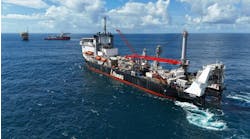Coflexip Stena Offshore
Liquefaction of natural gas has been performed onshore historically, with LNG carriers being loaded and unloaded by means of articulated arms. Now the industry is looking to shift the lique faction process offshore, but sea conditions can present loading problems.
In response, Coflexip Stena Offshore initiated a program in September 1998 to develop and test a cryogenic flexible pipe structure able to transfer LNG from the floating unit to a tanker, taking into account the dynamic motions of both vessels. This is a joint industry project with the cooperation of BP Amoco, BHP, Chevron, Gaz de France, and Shell.
A previous study, launched in 1978, led to the design and testing of an 8-in. LNG flexible pipe structure. In the 1980s, the aim was to develop a long length of cryogenic flexible pipe using the same manufacturing processes as applied for traditional flexible pipes. However, the aims of this new research and development (R&D) program are quite different - to achieve an internal diameter of 16-in. or more, and a unit length of flexible pipe with a maximum length of 100 meters.
The pipe will be used for surface applications. It is not designed to sustain the hydrostatic external pressures of subsurface use. Other key features include:
- Appropriate insulation to avoid external ice formation, to reduce boil-off, and to ensure flexibility
- A high degree of flexibility
- Easy on-site installation
- A means for detecting leaks.
Fatigue life analysis
The LNG flexible pipe's fatigue performance is governed mainly by the performance of the corrugated hose. To determine a fatigue curve suitable for the design, two fatigue test campaigns have been launched at the facilities of the Institut Francais du Petrole. The test bench was designed by CSO and installed at IFP. It provides axial fatigue tests on two parallel 8-in. samples loaded at the sample strain level. Fatigue test parameters, which can be piloted, are as follows:
- Applied mean strain (which can be in tension or compression)
- Applied alternating strain
- Inner pressure (samples are pressurized by air)
Leakage due to fatigue cracks signals the end of the test. The procedure is performed at room temperature. In the future, a 20-meter-long, full-scale 16-in. LNG flexible pipe sample will be manufactured to perform the following:
- Validation of the thermal insulation calculations
- Stiffness measurements
- Evaluation of the influence of pressure and low temperature, via axial, bending and torsion tests
- Pressure test at room temperature at 1.5 times the design pressure.
The full-scale LNG flexible pipe will be fatigue tested on a cryogenic flexion test rig. The rig will impose a plane flexion movement at a cyclic frequency of approximately 0.1 Hz. The LNG pipe will be pressurized at 10 bar with gaseous nitrogen at -160° C.
In conclusion, a 16-in. ID LNG flexible pipe structure is scheduled to be commercially available by end-2000, following dynamic test qualification. For internal diameters exceeding 16-in. (up to 24-in.), scheduled availability is mid-2001. The LNG flexible pipe will be designed on a case-by-case basis in order to propose a customized product for a specific project. This will require close collaboration between the end-users of the pipe and CSO.


